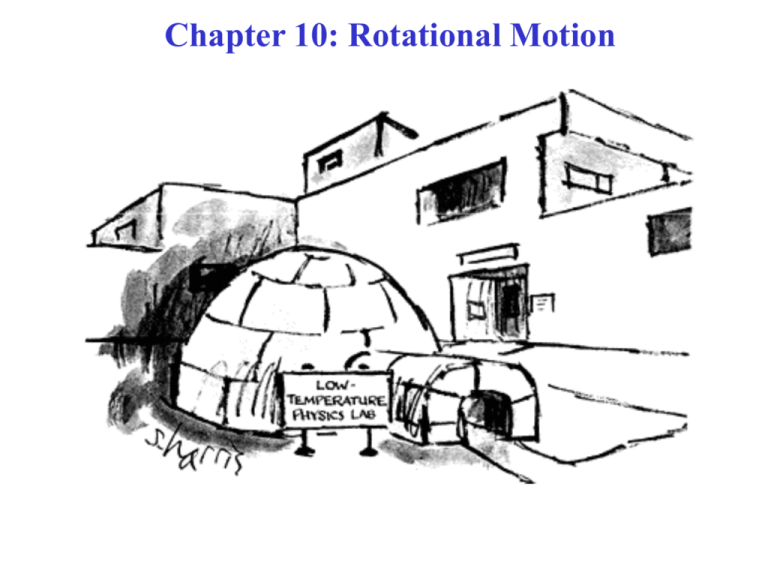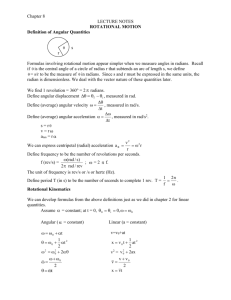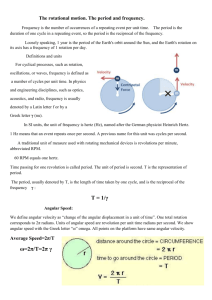Document
advertisement

Chapter 10: Rotational Motion • Topic of Chapter: Objects rotating – First, rotating, without translating. – Then, rotating AND translating together. • Assumption: Rigid Body – Definite shape. Does not deform or change shape. • Rigid Body motion = Translational motion of center of mass (everything done up to now) + Rotational motion about an axis through center of mass. Can treat the two parts of motion separately. COURSE THEME: NEWTON’S LAWS OF MOTION! • Chs. 4 - 9: Methods to analyze the dynamics of objects in TRANSLATIONAL MOTION. Newton’s Laws! – Chs. 4 - 6: Newton’s Laws using Forces – Chs. 7 & 8: Newton’s Laws using Energy & Work – Ch. 9: Newton’s Laws using Momentum. NOW • Chs. 10 & 11: Methods to analyze dynamics of objects in ROTATIONAL LANGUAGE. Newton’s Laws in Rotational Language! – First, Rotational Language. Analogues of each translational concept we already know! – Then, Newton’s Laws in Rotational Language. Rigid Body Rotation A rigid body is an extended object whose size, shape, & distribution of mass don’t change as the object moves and rotates. Example: CD Three Basic Types of Rigid Body Motion Pure Rotational Motion All points in the object move in circles about the rotation axis (through the Center of Mass) Reference Line The axis of rotation is through O & is to the picture. All points move in circles about O In purely rotational motion, all points on the object move in circles around the axis of rotation (“O”). The radius of the circle is R. All points on a straight line drawn through the axis move through the same angle in the same time. Sect. 10.1: Angular Quantities Positive Rotation! • Description of rotational motion: Need concepts: Angular Displacement Angular Velocity, Angular Acceleration • Defined in direct analogy to linear quantities. • Obey similar relationships! • Rigid object rotation: – Each point (P) moves in a circle with the same center! • Look at OP: When P (at radius R) travels an arc length ℓ, OP sweeps out angle θ. Reference Line θ Angular Displacement of the object • θ Angular Displacement • Commonly, measure θ in degrees. • Math of rotation: Easier if θ is measured in Radians • 1 Radian Angle swept out when the arc length = radius • When ℓ R, θ 1 Radian • θ in Radians is defined as: θ = ratio of 2 lengths (dimensionless) θ MUST be in radians for this to be valid! Reference Line • θ in Radians for a circle of radius R, arc length ℓ is defined as: θ (ℓ/r) • Conversion between radians & degrees: Or Or θ for a full circle = 360º = (ℓ/R) radians Arc length ℓ for a full circle = 2πR θ for a full circle = 360º = 2π radians 1 radian (rad) = (360/2π)º 57.3º 1º = (2π/360) rad 0.017 rad Angular Displacement: Ex. 10-1: Birds of prey—in radians A particular bird’s eye can just distinguish objects that subtend an angle no smaller than about θ = 3 10-4 rad. a. How many degrees is this? b. How small an object can the bird just distinguish when flying at a height of 100 m? Angular Displacement Angular Velocity (Analogous to linear velocity!) Average Angular Velocity = angular displacement θ = θ2 – θ1 (rad) divided by time t: (Lower case Greek omega, NOT w!) Instantaneous Angular Velocity (Units = rad/s) The SAME for all points in the object! Valid ONLY if θ is in rad! Angular Acceleration (Analogous to linear acceleration!) • Average Angular Acceleration = change in angular velocity ω = ω2 – ω1 divided by time t: (Lower case Greek alpha!) • Instantaneous Angular Acceleration = limit of α as t, ω 0 (Units = rad/s2) The SAME for all points in body! Valid ONLY for θ in rad & ω in rad/s!









